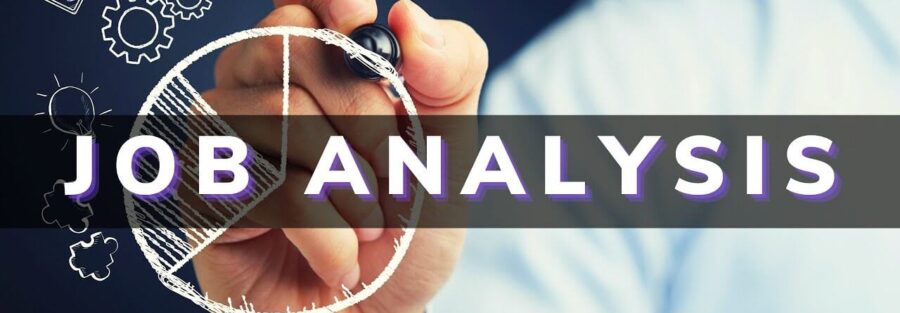تحليل الوظيفة
Job Analysis
ويسمى أيضًا
(Human Resource Audit) مراجعة الموارد البشرية
(Job Study) الدراسة الوظيفية
(Occupational Analysis) التحليل المهني
تعتمد المنظمات على تحليل الوظيفة في اتخاذ القرارات المناسبة فيما يتعلق بإدارة الموظفين والاستقطاب كما تعتبر مخرجات تحليل الوظيفة بمثابة المصدر الأساس لتحديد معايير الأداء وكذلك توفير المعلومات المتعلقة بالموظفين وتحديد الاحتياجات التدريبية وتطويرها، في هذا المقال سنتعرف عن مفهوم تحليل الوظيفة واستخداماته وأشكاله
مفهوم تحليل الوظيفة:
هو عملية جمع وتحليل المعلومات حول وظيفة موجودة في سوق العمل لتحديد المعرفة والمهارات والقدرات اللازمة لأداء المهمة بفعالية ويجب تغطية المجالات التالية في تحليل الوظائف:
- الواجبات والمسؤوليات الوظيفية: قائمة بالمهام والمسؤوليات الضرورية لأداء الوظيفة.
- المعرفة والمهارات: المعرفة والمهارات والقدرات المطلوبة لأداء الوظيفة، بما في ذلك المؤهلات التعليمية.
- ظروف آداء الوظيفة: السياق المادي والاجتماعي والتنظيمي الذي يتم فيه أداء الوظيفة، بما في ذلك بيئة العمل والأدوات والمعدات المستخدمة والمعايير الاجتماعية والثقافية لمكان العمل.
- معايير الأداء: المستوى المتوقع للأداء للوظيفة، بما في ذلك أي معايير كمية أو نوعية تستخدم لتقييم الأداء.
- السلوكيات المطلوبة: السلوكيات المحددة المطلوبة لأداء المهمة بنجاح، مثل مهارات الاتصال والعمل الجماعي وقدرات حل المشكلات.
- متطلبات التدريب: التدريب المطلوب لأداء المهمة بفعالية، بما في ذلك أي تدريب أثناء العمل أو برامج تدريبية خارجية.
- الإشراف: مستوى الإشراف المطلوب للوظيفة، بما في ذلك درجة الاستقلالية وسلطة صنع القرار الممنوحة لصاحب الوظيفة.
- الراتب والمزايا: الراتب والمزايا المرتبطة بالوظيفة، بما في ذلك أي هياكل مكافآت أو عمولة وحزم مزايا.
- فرص التطوير الوظيفي: فرص التطوير الوظيفي المرتبطة بالوظيفة، بما في ذلك إمكانية التقدم أو الحركة الجانبية داخل المنظمة.
- اعتبارات السلامة والصحة: أي اعتبارات تتعلق بالسلامة والصحة مرتبطة بالوظيفة، بما في ذلك المطالب المادية أو التعرض للمواد الخطرة أو أي مخاطر محتملة أخرى على صحة صاحب الوظيفة أو سلامته.
متى يستخدم تحليل الوظيفة:
- التوظيف والاختيار: يمكن استخدام تحليل الوظائف لتحديد المهارات والمعارف والقدرات اللازمة لوظيفة معينة، والتي يمكن أن تساعد في تصميم إعلانات وظيفية فعالة واختيار أفضل المرشحين للوظيفة.
- تقييم الأداء: يمكن استخدام تحليل الوظائف لوضع معايير الأداء، والتي يمكن أن تساعد في تقييم أداء الموظفين وتحديد مجالات التحسين.
- التدريب والتطوير: يمكن استخدام تحليل الوظائف لتحديد المعارف والمهارات والقدرات المحددة المطلوبة للوظيفة، والتي يمكن أن تساعد في تصميم برامج التدريب والتطوير الفعالة.
- التعويضات والمزايا: يمكن استخدام تحليل الوظائف لتحديد القيمة النسبية للوظائف المختلفة داخل المنظمة، والتي يمكن أن تساعد في إنشاء حزم تعويضات واستحقاقات عادلة ومنصفة.
- تصميم الوظائف وإعادة تصميمها: يمكن استخدام تحليل الوظائف لتحديد فرص تحسين تصميم الوظائف، مثل تبسيط المهام الوظيفية أو إدخال تقنيات جديدة، لجعل الوظائف أكثر كفاءة وفعالية.
بشكل عام، يعد تحليل الوظائف أداة مفيدة لفهم متطلبات الوظيفة وكيفية ملاءمتها للمنظمة، ويمكن استخدامها في مجموعة واسعة من أنشطة الموارد البشرية.
كيف تجمع البيانات لتحليل الوظيفة:
يمكن أن يتخذ تحليل الوظيفة أشكالا عديدة اعتمادا على المنظمة والاحتياجات المحددة للوظيفة. تشمل بعض الأشكال الشائعة لتحليل الوظائف ما يلي:
- استبيانات تحليل الوظائف: هذه استبيانات موحدة يكملها أصحاب الوظائف أو المشرفون أو الخبراء المتخصصين لجمع معلومات حول واجبات الوظيفة ومسؤولياتها ومهاراتها المطلوبة.
- المقابلات: يمكن استخدام المقابلات الفردية مع أصحاب الوظائف أو المشرفين أو الخبراء المتخصصين لجمع المعلومات حول مهام الوظيفة ومسؤولياتها والمعارف والمهارات المطلوبة.
- الملاحظة: يمكن استخدام المراقبة المباشرة لأصحاب الوظائف لجمع المعلومات حول مهام الوظيفة والمطالب المادية والظروف البيئية.
- مجموعات التركيز: يمكن استخدام مجموعات التركيز لجمع المعلومات من مجموعات من أصحاب الوظائف أو الخبراء المتخصصين حول واجبات الوظيفة ومسؤولياتها ومهاراتها المطلوبة.
- تقنية الحوادث الخطيرة: تتضمن هذه الطريقة جمع معلومات حول حوادث أو مواقف محددة تظهر أداء وظيفيا فعالا أو غير فعال.
- بيانات الأداء الوظيفي: يمكن أن يساعد تحليل بيانات الأداء الوظيفي الفعلية، مثل مقاييس الإنتاجية أو الجودة، في تحديد الواجبات والمسؤوليات والمهارات الرئيسية المطلوبة للوظيفة.
- يوميات العمل: يمكن لأصحاب الوظائف الاحتفاظ بسجل لأنشطتهم على مدى فترة من الزمن، والتي يمكن أن توفر معلومات مفصلة عن الواجبات والمسؤوليات والمهارات المطلوبة للوظيفة.
سيعتمد النموذج المحدد المستخدم لتحليل الوظائف على احتياجات المنظمة ومواردها، وقد يتضمن مجموعة من الأساليب لجمع معلومات شاملة ودقيقة عن الوظيفة.
مخرجات التحليل الوظيفي:
يمكن أن تختلف مخرجات التحليل الوظيفي اعتمادا على الغرض من التحليل ونطاقه. ومع ذلك، تشمل بعض المخرجات المشتركة لتحليل الوظائف ما يلي:
الوصف الوظيفي: ملخص مكتوب للواجبات والمسؤوليات الرئيسية للوظيفة، إلى جانب المعرفة والمهارات والقدرات المطلوبة.
مواصفات الوظيفة: ملخص مكتوب للمؤهلات المحددة والتعليم والخبرة والخصائص الأخرى المطلوبة للأداء الوظيفي الناجح.
معايير الأداء: أوصاف مكتوبة للمستوى المتوقع من الأداء للوظيفة، بما في ذلك أي معايير كمية أو نوعية تستخدم لتقييم الأداء.
المواد التدريبية: وصف مفصل للمعرفة والمهارات والقدرات المطلوبة للوظيفة، والتي يمكن استخدامها لتطوير المواد والبرامج التدريبية.
اختبارات وإجراءات الاختيار: يمكن أن يوفر تحليل الوظائف المعلومات اللازمة لتصميم اختبارات وإجراءات الاختيار التي تقيس بدقة المعرفة والمهارات والقدرات المطلوبة للوظيفة.
توصيات إعادة تصميم الوظائف: يمكن لتحليل الوظائف تحديد فرص تحسين تصميم الوظائف، مثل تبسيط المهام الوظيفية أو إدخال تقنيات جديدة، لجعل الوظائف أكثر كفاءة وفعالية.
بشكل عام، توفر مخرجات تحليل الوظائف معلومات قيمة يمكن استخدامها لتحسين الأداء التنظيمي، وتعزيز رضا الموظفين ومشاركتهم، ودعم الإدارة الفعالة للموارد البشرية.
نأمل أن تكون هذه المقالة قد أعطت مقدمة واضحة حول مفهوم تحليل الوظيفة واستخداماته وأهميته الفعالة للموارد البشرية والمنظمة بشكل عام.




